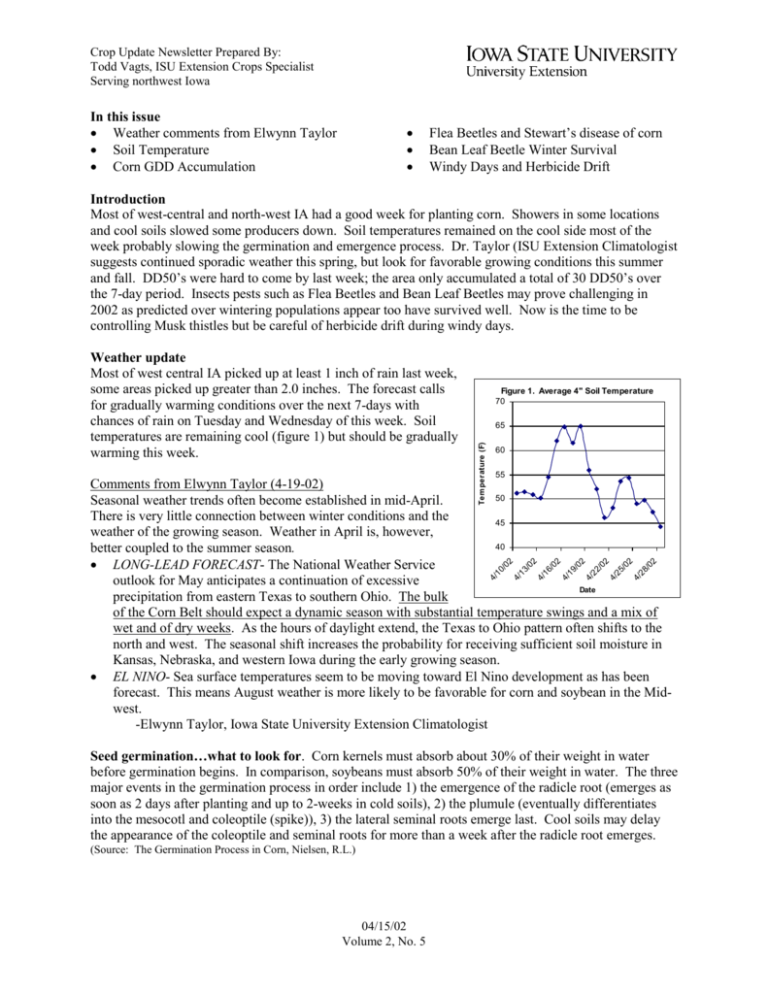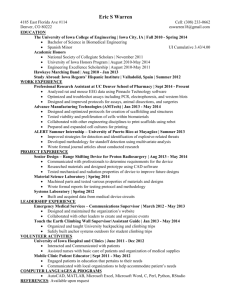Introduction - Iowa State University Extension and Outreach
advertisement

Crop Update Newsletter Prepared By: Todd Vagts, ISU Extension Crops Specialist Serving northwest Iowa In this issue Weather comments from Elwynn Taylor Soil Temperature Corn GDD Accumulation Flea Beetles and Stewart’s disease of corn Bean Leaf Beetle Winter Survival Windy Days and Herbicide Drift Introduction Most of west-central and north-west IA had a good week for planting corn. Showers in some locations and cool soils slowed some producers down. Soil temperatures remained on the cool side most of the week probably slowing the germination and emergence process. Dr. Taylor (ISU Extension Climatologist suggests continued sporadic weather this spring, but look for favorable growing conditions this summer and fall. DD50’s were hard to come by last week; the area only accumulated a total of 30 DD50’s over the 7-day period. Insects pests such as Flea Beetles and Bean Leaf Beetles may prove challenging in 2002 as predicted over wintering populations appear too have survived well. Now is the time to be controlling Musk thistles but be careful of herbicide drift during windy days. Figure 1. Average 4" Soil Temperature 70 65 Tem perature (F) Weather update Most of west central IA picked up at least 1 inch of rain last week, some areas picked up greater than 2.0 inches. The forecast calls for gradually warming conditions over the next 7-days with chances of rain on Tuesday and Wednesday of this week. Soil temperatures are remaining cool (figure 1) but should be gradually warming this week. 60 55 /0 2 /0 2 4/ 28 /0 2 4/ 25 /0 2 4/ 22 /0 2 4/ 19 /0 2 4/ 16 4/ 13 4/ 10 /0 2 Comments from Elwynn Taylor (4-19-02) 50 Seasonal weather trends often become established in mid-April. There is very little connection between winter conditions and the 45 weather of the growing season. Weather in April is, however, 40 better coupled to the summer season. LONG-LEAD FORECAST- The National Weather Service outlook for May anticipates a continuation of excessive Date precipitation from eastern Texas to southern Ohio. The bulk of the Corn Belt should expect a dynamic season with substantial temperature swings and a mix of wet and of dry weeks. As the hours of daylight extend, the Texas to Ohio pattern often shifts to the north and west. The seasonal shift increases the probability for receiving sufficient soil moisture in Kansas, Nebraska, and western Iowa during the early growing season. EL NINO- Sea surface temperatures seem to be moving toward El Nino development as has been forecast. This means August weather is more likely to be favorable for corn and soybean in the Midwest. -Elwynn Taylor, Iowa State University Extension Climatologist Seed germination…what to look for. Corn kernels must absorb about 30% of their weight in water before germination begins. In comparison, soybeans must absorb 50% of their weight in water. The three major events in the germination process in order include 1) the emergence of the radicle root (emerges as soon as 2 days after planting and up to 2-weeks in cold soils), 2) the plumule (eventually differentiates into the mesocotl and coleoptile (spike)), 3) the lateral seminal roots emerge last. Cool soils may delay the appearance of the coleoptile and seminal roots for more than a week after the radicle root emerges. (Source: The Germination Process in Corn, Nielsen, R.L.) 04/15/02 Volume 2, No. 5 Crop Update Newsletter Prepared By: Todd Vagts, ISU Extension Crops Specialist Serving northwest Iowa Growing Degree Day Accumulation The area accumulated only 30 DD50’s over the last 7 days and is projected to accumulate only 35 to 40 over the next 7 days (Figure 2). Remember, corn typically requires 110 GDD50’s for emergence. Start looking for emergence on the earliest planted fields (April 15 – 17) now. Figure 2. GDD Acccumulation (4/28) In Figure 2, the line with squares equates to Monona, Crawford, Carroll and southern Ida, Sac and Calhoun counties. The line with Diamonds equates to Pocahontas, Buena Vista and northern Ida, Sac, and Calhoun counties. The dotted line is predicted GDD and crop development in 7 days. 160 120 --------------------Emergence-------------------100 80 60 40 20 0 /0 4/ 1 16 /0 4/ 1 17 /0 4/ 1 18 /0 4/ 1 19 /0 4/ 1 20 /0 4/ 1 21 /0 4/ 1 22 /0 4/ 1 23 /0 4/ 1 24 /0 4/ 1 25 /0 4/ 1 26 /0 1 Accumulated DD50's 140 4/ 15 Pest Management High risk for Stewart's disease of corn in Iowa for 2002 Although the corn flea beetle populations were quite low throughout most of Iowa during the 2001 growing season, the 2001-2002 winter was one of the warmest on record and ISU Extension Specialists are predicting a high risk for the occurrence of Stewart's disease in the 2002 growing season. Based on 30 years of historical disease and weather data, we are predicting that 10-15 percent of the seed corn fields in Iowa will have Stewart's disease in 2002. 180 Planting Date (by Forrest W. Nutter, Jr., Gary Munkvold and Paul Esker, Department of South North 7-Day Forecast Plant Pathology, and Marlin Rice, Department of Entomology) For more information, visit the following web site: http://www.ipm.iastate.edu/ipm/icm/2002/4-29-2002/stewart2002.html Bean Leaf Beetle Winter Survival Predicted to be High. Due to high populations last fall going into dormancy and the mild winter, over winter mortality of the bean leaf beetle is predicted to be low. This could mean high populations this spring as the beetles emerge from their over-wintering hide-outs. 36 to 45 percent of the over-wintered beetles are predicted to emerge this spring in west-central and north-west Iowa. This is compared to a 13-year average in central Iowa of 29% winter survival. For more information go to http://www.ipm.iastate.edu/ipm/icm/2002/429-2002/blbwinter.html Thistle Control Musk thistle treatment should begin in early May. The key to good control of musk thistle with herbicides is to control young plants in early May while they're in the rosette stage. Treatment after bolting is less effective because seeds may still develop. Uncontrolled plants can produce up to 20,000 seeds. For more information on control options, visit the CropWatch web site http://cropwatch.unl.edu/ (Alex Martin, Extension Weeds Specialist, University of NE.) Wind and Herbicide Drift If you think we’ve had more “high” wind days this spring you are thinking correctly. In March and April of this year, northwest Iowa has had 27 days (out of 55) with average daily wind speeds over 10 mph. This compares to an average of 23 days over the previous 4 years. Additionally, the area has had more days (9) with average wind speed over 15 mph compared to the last 5 years. Why is this important? March and April is the time when farmers spray herbicides on crop fields to control troublesome weeds. Wind speeds over 10 mph greatly increase the risk of herbicide drift and potential off-target injury. Additionally, pesticide drift complaints registered by the Iowa Department of Agriculture have increased every year over the last 6 years. With the challenge to timely apply pesticides in low wind conditions and the increasing frustration of rural residents with off-target injury problems, several management strategies need to be employed to reduce the risk of off-target injury. For more information, visit the following web site http://extension.iastate.edu/carroll/crops/herbicide_drift.htm 04/15/02 Volume 2, No. 5 Crop Update Newsletter Prepared By: Todd Vagts, ISU Extension Crops Specialist Serving northwest Iowa For further information pertaining to this newsletter; please contact me or any of the county extension offices. This newsletter can also be accessed on-line at http://extension.iastate.edu/carroll/crops/newsletters_2002.htm. If you would like this letter to be emailed directly to you, please send an email with the desired email address to vagts@iastate.edu. ****************************************************************************** Todd Vagts Iowa State University Extension Field Specialist, Crops 1240 D. Heires Avenue Office: 712-792-2364 Carroll, IA 51401 Cell: 712-249-6025 Email: vagts@iastate.edu Fax: 712-792-2366 Web Page: http://extension.iastate.edu/carroll/crops/homepage.html Provided to you by: IOWA STATE UNIVERSITY OF SCIENCE AND TECHNOLOGY COOPERATIVE EXTENSION Iowa State University and U.S. Department of Agriculture cooperating Extension programs are available to all without regard to race, color, national origin, religion, sex, age or disability. 04/15/02 Volume 2, No. 5







